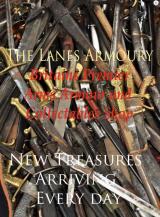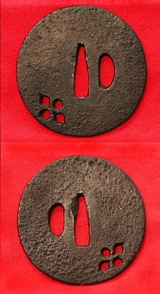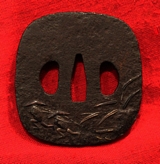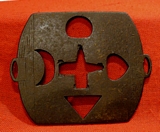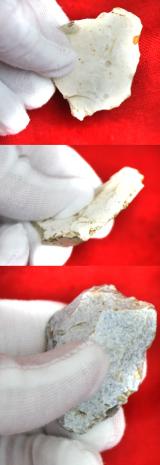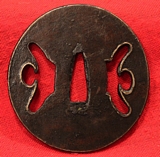Ko Tosho School Swordsmith Made Koto Katana Tsuba Circa 1400
The strong, softly lustrous metal and very well cut, the large Hitsu-ana, and the antique chisel marks around the Hitsu-ana are all characteristic indications of early-Muromachi period works. Carved openwork clan mon. The Hitsu-ana, made when the guard was first produced, suggests that it is a work of the time of Yoshimitsu. A well worked and hammered plate. According to tradition, it says each time a Tosho made a to-ken, he made a habaki with his own hands, and at the same time he also added a single tsuba such as this.
The earliest Tosho tsuba are referred to in Japanese as Ko-Tosho old sword smith and date from the Genpei War (1180-1185) to middle Muromachi Period (1400-1500).
During the late Kamakura Period large Ko-Tosho tsuba were developed and were used mostly as field mounts for odachi by high-ranking Samurai during and after the Mongol invasion of Japan in Genko Jidai (1274-1281 ) in the Muromachi Period (1336-1573) the Ko-Tosho tsuba became even more common with the development and popularization of the onehanded sword uchigatana as the only sword of Ashigaru.
The most common design characteristic, next to the plain flat plate, for Ko-Tosho tsuba is kosukashi the simplistic use of small negative silhouetted openwork. The most common openwork designs are of mon (family crest), sun, moon, tools, plants, Buddhist, Shinto and sometimes Christian religious symbols. The plates iron is characteristically of a good temper, having good hardness and elasticity. The plate is made of local iron forged by the swordsmith or apprentice, the same as for Japanese sword blades. 74mm read more
750.00 GBP
An Iron Plate Katana Edo Tsuba Decorated With Small Figures In Rain Garb
Circa 1650. Small fishermen towing nets wearing rain hats and tied straw body coverings. With large fauna as a side decoration. With kozuka and kogaiana. The Tsuba can be solid, semi pierced of fully pierced, with an overall perforated design, but it always a central opening which narrows at its peak for the blade to fit within. It often can have openings for the kozuka and kogai to pass through, and these openings can also often be filled with metal to seal them closed. For the Samurai, it also functioned as an article of distinction, as his sole personal ornament read more
395.00 GBP
A Most Unusual & Rare Edo Period Katana Tsuba, With Rotational Fitting. This is An Incdibly Rare Form of Tsuba in that it Has Two Methods To Mount It On Katana. Vertical or Horizontal
An iron sukashi tsuba, cut with four different shaped symbols as kozuka-ana and kogai-ana, and two, North and South, or East and West facing blade apertures, to enable the rotation of the tsuba when mounting it onto the blade. Thus altering the profile of the tsuka from wide to narrow.
The tsuba is always usually a round, ovoid or occasionally squarish guard at the end of the tsuka of bladed Japanese weapons but always usually designed to be worn one way upon the sword, either the katana and its various declinations, tachi, wakizashi, tanto, and polearms that have a tsuba, such as naginata etc.
They contribute to the balance of the weapon and to the protection of the hand. The tsuba was mostly meant to be used to prevent the hand from sliding onto the blade during thrusts as opposed to protecting from an opponent's blade. The chudan no kamae guard is determined by the tsuba and the curvature of the blade. The diameter of the average katana tsuba is 7.58 centimetres (3.0-3.1 in), wakizashi tsuba is (2.4-2.6 in), and tanto tsuba is 4.5-6 cm (1.8-2.4 in).
During the Muromachi period (1333-1573) and the Momoyama period (1573-1603) Tsuba were more for functionality than for decoration, being made of stronger metals and designs. During the Edo period (1603-1868) tsuba became more ornamental and made of less practical metals such as gold.
Tsuba are usually finely decorated, and are highly desirable collectors' items in their own right. Tsuba were made by whole dynasties of craftsmen whose only craft was making tsuba. They were usually lavishly decorated. In addition to being collectors items, they were often used as heirlooms, passed from one generation to the next. Japanese families with samurai roots sometimes have their family crest (mon) crafted onto a tsuba. Tsuba can be found in a variety of metals and alloys, including iron, steel, brass, copper and shakudo. In a duel, two participants may lock their katana together at the point of the tsuba and push, trying to gain a better position from which to strike the other down. This is known as tsubazeriai pushing tsuba against each other. read more
585.00 GBP
A Superb Edo Period Umetada Tsuba Signed Yamashiro kuni ju Umetada Shigenari, From the Umetada Line Of Tsuba Makers of Yamashiro. Of A Carved Takebori Kitsune {Fox} Going To The Kitsune no Yomeiri {The Foxe's Wedding}
Yamashiro kuni ju Umetada shigenari, from the Umetada family residing in the province of Yamashiro, active around 1650-1700.
With a most rare feature of the punch in order to create a narrowing of the nakago-ana, bears numerous strikes of a clan mon of six plum blossom petals. At the area around the nakago-ana note there are tagane-ato (punch marks around the nakago-ana) in the form of mon
The Umetada school was one of the pivotal centres of sword-related arts between the late Momoyama period and the early Edo era. Founded in Kyōto, it stood out for its versatility and outstanding quality, covering all fields associated with the katana: restorations, horimono, suriage, kinzogan-mei, crafting of habaki, and mountings — most of these works commissioned through collaboration with the Hon’ami family, who retained exclusive rights for polishing and appraisal services.
The Umetada school was a renowned family of tsuba (sword guard) makers in Kyoto, founded in the late 16th century by Umetada Myōju. The school is known for its innovative combination of chiseling and inlay work, creating tsuba with a wide variety of styles, including intricate designs, soft metal inlays, and even European-influenced motifs. Key members of the school included Umetada Myōju, Umetada Mitsutada, Myōshin, and Jusai.
Key features of the Umetada school
Innovative techniques: The school combined traditional chiseling and inlay (zogan) techniques with unique designs.
Versatile subject matter: Tsuba often featured natural motifs like snow crystals and leaves
Use of soft metals: They were known for using soft metals like copper and brass, often with inlays of gold, silver, or shakudo.
One the principle side is the fox dressed in formal garb with a hat with his iconic big fluffy tail, and at his feet is a bound bag of precious gifts. On the opposing side is a mountain scene with the small fox figure, carrying the bag of precious gifts on a pole, wearing a jingasa hat, walking the mountain path.
The Foxes' Wedding
is less a single continuous narrative and more a widespread folk belief used to explain a specific natural phenomenon: a sunshower, where rain falls while the sun is shining. People in rural Japan once believed this meant a kitsune wedding was taking place just beyond human sight.
On a day when the sun and rain appear together, an invisible (or nearly invisible) procession of foxes can be seen or heard moving through the fields or mountains.
The foxes in the procession, having used their magical abilities to take on human form, wear traditional Japanese wedding attire. The bride wears a white kimono (a bridal kimono) and a traditional headdress, while the groom may be in formal black attire. Other fox guests wear splendid kimonos with their family crests.
The groom in traditional formal wear would wear a traditional formal hat (like an eboshi or kanmuri), fitting the description of a "fox wearing a kimono and hat" in human form for the ceremony.
The procession is often lit by kitsunebi (fox-fire), ethereal fireballs breathed out by the foxes to light their way through the night.
Human Encounters: Humans who accidentally witnessed this rare event were traditionally warned to stay indoors to avoid disruption, which could bring bad luck. Sometimes, a human might stumble upon the wedding and either be granted good fortune or become bewitched if they spoke of it.
This belief is a popular motif in traditional Japanese art (ukiyo-e prints) and theatre, such as Kabuki, where actors would wear fox masks and elaborate costumes to portray the characters. read more
995.00 GBP
A Very Good, WW1 & WW2 Original Horseguards, Life Guards and Blues And Royals, Other Ranks Pattern Helmet Plate, Order of the Garter Badge Star. For The Mounted Bodyguard of The King
Ideal for a collector that has a helmet lacking its badge. This badge could add a thousand pounds of value to a helmet missing its original badge.
Original, early King's Crown type. This fabulous quality WW1 and WW2 other ranks badge, was in use since 1901, used by a trooper or NCO of the Blues and Royals or the Life Guards, that combined, make up the Royal Horseguards, until the pattern was changed with the queen's crown in 1953. The Albert helmet is the current ceremonial headgear of the British Army's Household Cavalry, the Life guards regiment and the Blues and Royals regiment. It was introduced by Prince Albert in 1842 and adopted by the Household Cavalry the following year. In 1847 the helmet was introduced to all heavy cavalry regiments. It remains in use as the full dress headgear of the two remaining Household Cavalry regiments, the Blues and Royals and the Life Guards. The magnificent helmet remains in use with the two current Household Cavalry regiments, the Blues and Royals with red plume and the Life Guards with white plume. These regiments are amalgamations of the four earlier regiments. The Life Guards retain the white plume and the onion from the 2nd Regiment, the Blues and Royals retain the red plume of the Royal Horse Guards. Blues and Royals officers wear a yak hair plume. Farriers in both regiments wear different plumes, the Life Guards farrier wear black and Blues and Royals farrier red.
The regiments also differ in how they wear the helmet's chin strap. The Blues and Royals wear it under the chin while the Life Guards wear it under the lower lip. The helmet is now in white metal for all ranks and the same helmet plate is worn by both regiments (they were different historically).
The Albert helmet is only worn in full dress review order, guard order and front yard order by other ranks and in full dress, levee dress and ceremonial rehearsal dress by officers. Medical and veterinary officers do not wear the helmet, instead wearing a cocked hat.
The other ranks of the Mounted Band of the Household Cavalry wear the helmet in full dress (with the plumes of their parent regiments), except when parading in the presence of the royal family, when they wear state dress with jockey caps. Band officers wear Albert helmets on both occasions.
one threaded affixing bolt remaining and one fold out helmet affixing stem read more
435.00 GBP
Group of Three Neolithic Stone Age 'Scraper' Flints Around 5000 Years Old. Arthur Halcrow Versage Collection. Possibly An Ideal & Unique Gift Idea For Christmas
3 Parts of Stone Age Scraper Group. Hand knapped by a Stone Age person in Britain around 5000 years ago, from whole flints to create three scraping tools.
Neolithic, 3rd millennium BC.
From our acquisition of the Arthur Halcrow Versage collection, Reigate, Surrey, UK; discovered from Hallard’s Fen, Burwell, Cambridgeshire, in 1969. In the Neolithic period (later stone age) people started to settle down and start farming. At places such as Springfield Lyons, these early settlements have been identified. It was also at this time when stone tools, which up until this point had been purely functional, started to take on a more symbolic meaning. Polished stone axes and other tools that were never used have been found across the county, showing changes in social hierarchy and possibly even the development of religion.
The Neolithic also known as the "New Stone Age", the final division of the Stone Age, began about 12,000 years ago when the first development of farming appeared in the Epipalaeolithic Near East, and later in other parts of the world. The division lasted until the transitional period of the Chalcolithic from about 6,500 years ago (4500 BC), marked by the development of metallurgy, leading up to the Bronze Age and Iron Age. In Northern Europe, the Neolithic lasted until about 1700 BC, while in China it extended until 1200 BC. Other parts of the world (the New World) remained in the Neolithic stage of development until European contact.
The Neolithic comprises a progression of behavioral and cultural characteristics and changes, including the use of wild and domestic crops and of domesticated animals.
The term Neolithic derives from the Greek neos and lithos "New Stone Age". The term was coined by Sir John Lubbock in 1865 as a refinement of the three-age system..
Generic photos in the gallery of three from the Neolithic flints in the collection. read more
125.00 GBP
A Late Koto to Early Shinto Period Katana Round Plate Tsuba. Outline Inlaid With Flattened Sinchu Around the Sukashi Piercings
The piercing has been outlined with a borderline of inlaid brass. Circa 1600. Tsuba were made by whole dynasties of craftsmen whose only craft was making tsuba. They were usually lavishly decorated. In addition to being collectors items, they were often used as heirlooms, passed from one generation to the next. Japanese families with samurai roots sometimes have their family crest (mon) crafted onto a tsuba. Tsuba can be found in a variety of metals and alloys, including iron, steel, brass, copper and shakudo. In a duel, two participants may lock their katana together at the point of the tsuba and push, trying to gain a better position from which to strike the other down. This is known as tsubazeriai pushing tsuba against each other. read more
465.00 GBP
A Superb Near Mint French Gras Rifle Sword Bayonet. 450,000 Rifles and These Bayonets Were Sold To Russia For WW1 Eastern Front and Used In The Russian Revolution By The Bolshevik Red Guards & the Imperial White Russians From 1918-1921
The French Gras rifle was primarily used by France from its adoption in 1874 until it was replaced by the Lebel rifle in 1886. While it was the primary service rifle during this period, it also saw use in later conflicts, including World War I, primarily by the Imperial Russians and then both revolutionary armies, the royalist White Russians and Bolshevick Red Guards in the Russian Civil War. Matching serial numbers to scabbard and sword, and all the surviving Russian export Gras bayonets we have had in the past had matching numbers like this superb example, but the French service examples are usually 99/100 miss-matched.
Fully conserved by hand in our workshop.
The Russian Civil War (1918-21) was fought for control of Russia after the October Revolution. A conglomerate of anti-Bolshevik groups, loosely dubbed the Whites, sought to remove the Bolsheviks from power and restore at least some elements of the old order. Other groups not directly aligned with either the Bolsheviks or Whites fought for control or independence in their own regions. The Russian Civil War was a pervasive conflict that involved disparate political and military groups, nationalist movements and all classes of Russian society. Foreign nations opposed to the Bolshevik regime also contributed troops, weapons, supplies and intelligence. Like other internecine conflicts, the Russian Civil War would produce confusion, division, attack and retaliation, intense propaganda, war crimes and human suffering on catastrophic levels.
1874-1886: The Gras was the standard French infantry rifle, replacing the Chassepot and being the first French service rifle to use metallic cartridges.
Post-1886: The Lebel rifle began to replace it as the primary service weapon, but the Gras remained in use for training purposes.
World War I: The Gras was still in service in 1914 and was used for training in the early stages of the war. Some were even converted to fire the new 8mm Lebel cartridge.
Other uses: While not a primary combat weapon for France after the Lebel's introduction, the Gras rifle was also used by other nations, including the Greek army during World War II, and especially by the Russian Empire and Bolsheviks after France supplied them with 450,000 rifles in 1915 due to Russian arms shortages
We acquired two, but each will be offered separately after full hand conservation.
We show two Russian Civil war propaganda posters in the gallery for historical perspective only. One Red Russian, one White Russian read more
A Simply Beautiful Ancient Koto Katana, Sengoku Era, Circa 1530, Signed Fuchi with Artisans Kakihan of a Cursive Monogram and Signed Tsuba, And the Matsudaira Tokugawa Clan Mon Gold Habaki
Beautiful Koto blade with wonderful quality original Edo fittings of a signed fushi hilt mount of shakudo and pure gold, with a takebori samurai daimyo lord, in court dress, wearing his tachi.
Very good tsuba in iron, also signed. Menuki of cranes underneath the silk ito. Very beautiful blade with typical Koto period narrow straight hamon of fine simplicity. Engraved gilt habaki blade collar with Tokugawa clan mon of Aoi hollyhock leaves. Original utushi lacquer saya with small wear areas. Bound with dark red and white sageo.
Before the Edo period, there were 19 major branches of the Matsudaira clan: Takenoya (竹谷), Katanohara (形原),4 Ōgusa (大草), Nagasawa (長沢),5 Nōmi (能見),6 Goi (五井), Fukōzu (深溝), Ogyū (大給),7 Takiwaki (滝脇),8 Fukama (福釜), Sakurai (桜井), Tōjō (東条), Fujii (藤井),9 Mitsugi (三木), Iwatsu (岩津), Nishi-Fukama (西福釜), Yata (矢田), Udono (鵜殿), and Kaga (加賀). Each of these branches (with the exception of the Kaga-Matsudaira, which relocated to Kaga Province) took its name from the area in Mikawa where it resided. Also, many of the branches often fought with each other.
Matsudaira of Okazaki
It was the main Matsudaira line residing in Okazaki Castle which rose the highest during the Sengoku period. During the headship of Matsudaira Hirotada, it was threatened by the Oda and Imagawa clans, and for a time was forcibly brought into Imagawa service. After the death of Imagawa Yoshimoto and the fall from power of the Imagawa clan, Hirotada's son Matsudaira Motoyasu was successful in forming an alliance with Oda Nobunaga, the hegemon of Owari Province. Motoyasu is better known as Tokugawa Ieyasu, who became the first Tokugawa shōgun in 1603.
The Sengoku Period (Sengoku Jidai, 1467-1568 CE), also known as the Warring States Period, was a turbulent and violent period of Japanese history when rival warlords or daimyo fought bitterly for control of Japan. The period falls within the Muromachi period (Muromachi Jidai, 1333-1573 CE) of Japanese medieval history when the Ashikaga shogun capital was located in the Muromachi area of Heiankyo (Kyoto). The beginning of the Sengoku period witnessed the Onin War (1467-1477 CE) which destroyed Heiankyo. The fighting that followed over the next century would eventually reduce the warlords to only a few hundred in number as the country was effectively carved up into princedoms. Eventually, one warlord rose above all his rivals: Oda Nobunaga, who set Japan on the road to unification from 1568 CE.
To many of us in the West, the movie image of the samurai in his fantastic armour, galloping into battle on his horse, his colourful personal flag, or sashimono, whipping in the wind on his back, has become the very symbol of Japan, the Empire of the Rising Sun. And, truly, to the samurai of real life, nothing embodied his warrior's code of Bushido more than his sword, considered inseparable from his soul.
Indeed, a sword was considered such a crucial part of a samurai's life that when a young samurai was about to be born, a sword was brought into the bedchamber during the delivery. When the time came for an old samurai to die and cross over into the White Jade Pavilion of the Afterlife his honoured sword was placed by his side. Even after death, a daimyo, or nobleman, believed he could count on his samurai who had followed him into the next world to use their keen blades to guard him against any demons, just as they had wielded their trusty weapons to defend him against flesh-and-blood enemies in this life. Shakudo is a billon of gold and copper (typically 4-10% gold, 96-90% copper) which can be treated to form an indigo/black patina resembling lacquer. Unpatinated shakudo Visually resembles bronze; the dark colour is induced by applying and heating rokusho, a special patination formula.
Shakudo Was historically used in Japan to construct or decorate katana fittings such as tsuba, menuki, and kozuka; as well as other small ornaments. When it was introduced to the West in the mid-19th century, it was thought to be previously unknown outside Asia, but recent studies have suggested close similarities to certain decorative alloys used in ancient Egypt, Greece, and Rome read more
5750.00 GBP


